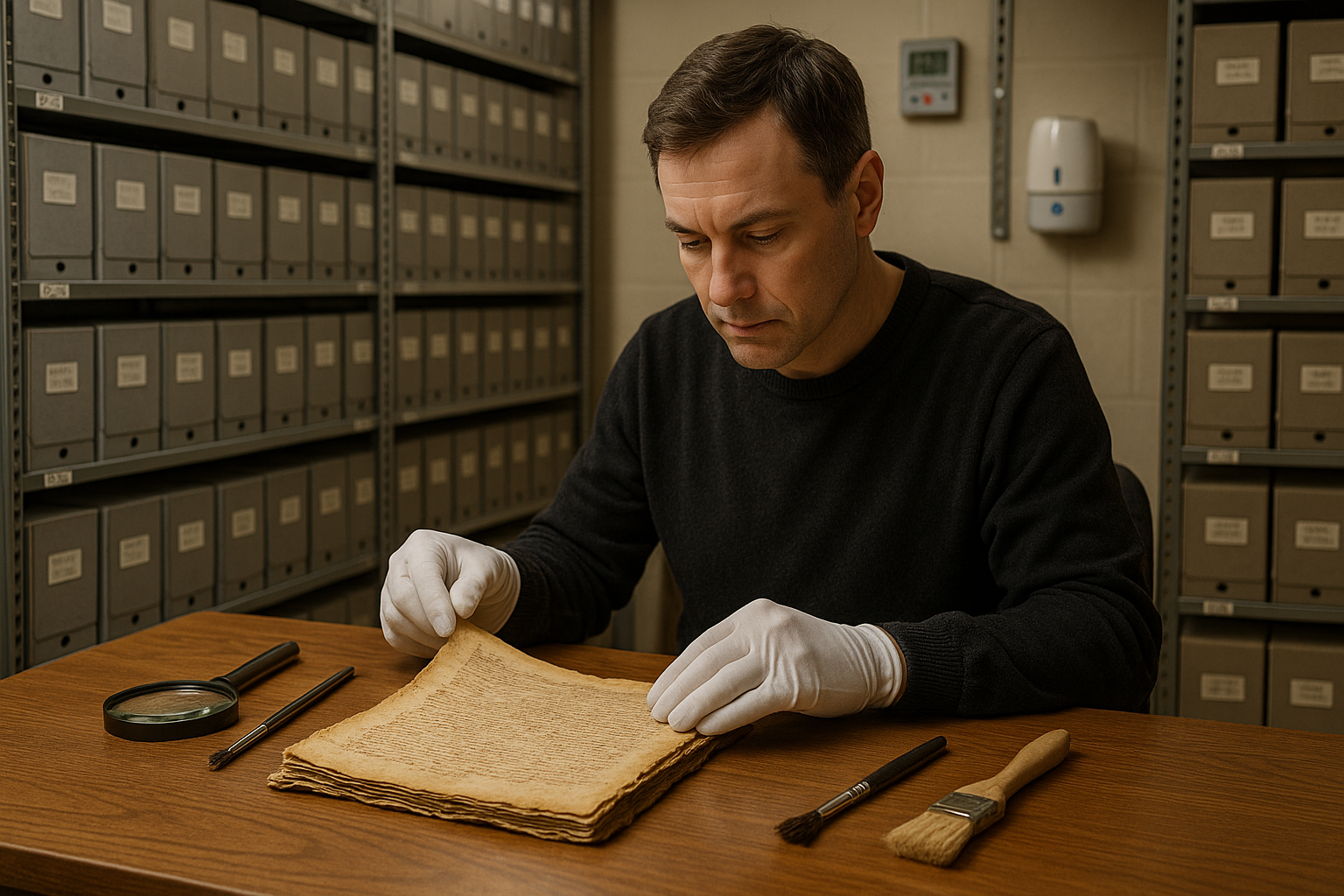In a world that’s constantly rushing towards the future, there lies a profound beauty and necessity in preserving the past. Our fragile documents—aged letters, historical manuscripts, and delicate photographs—are silent witnesses to times gone by, holding stories, wisdom, and insights that shaped the present. Yet, without proper care and attention, these invaluable pieces of history risk fading away, taking their secrets with them. 🕰️
Welcome to our comprehensive guide on archival storage for fragile documents. Here, we’ll delve into the art and science of preserving history. Whether you’re a seasoned archivist, a history enthusiast, or someone who has inherited a box of family treasures, this guide will provide you with the knowledge and tools you need to protect these delicate artifacts. After all, preserving history is not just about the past; it’s about safeguarding the narratives that inform our identity and guide our future.
The importance of archival storage cannot be overstated. Fragile documents require a specific set of conditions to remain intact over time. Temperature, humidity, light exposure, and handling methods all play a critical role in their longevity. This guide will walk you through each of these elements, offering practical tips and solutions that are both effective and accessible. 🗂️
We begin by exploring the fundamental principles of archival storage, emphasizing the importance of creating an environment that mimics the stable conditions found in professional archives. You’ll learn how to assess your current storage situation and make necessary adjustments to ensure the safety of your documents. From the basics of proper shelving to more advanced climate control techniques, we’ll cover everything you need to know to create a preservation-friendly space.
Next, we turn our attention to the materials and tools essential for document preservation. Not all storage solutions are created equal, and choosing the right products is crucial for long-term preservation. We’ll guide you through the selection process, helping you identify archival-quality boxes, folders, and protective coverings that will shield your documents from potential harm. 📦
Handling fragile documents is an art in itself. Improper handling can lead to irreversible damage, so we’ll share best practices for safely examining and transporting your historical materials. You’ll discover techniques that professionals use to minimize physical stress on documents, ensuring that they remain as pristine as possible.
In addition to physical preservation, we’ll explore the role of digital archiving. Technology offers powerful tools for preserving the content of fragile documents while reducing the need for frequent handling. Learn how to digitize your collection effectively, choosing the right equipment and software to create high-quality digital replicas. This section will also address the importance of metadata and digital storage solutions that ensure easy access and organization. 💻
Finally, we’ll discuss the ethical and legal considerations involved in archival storage. Preserving history is not just about the technical aspects; it involves respecting the cultural and personal significance of the documents. We’ll touch on topics like ownership rights, cultural sensitivity, and the responsibility of sharing historical information with integrity.
By the end of this guide, you will have a thorough understanding of archival storage for fragile documents. More importantly, you will be equipped with practical strategies to protect and preserve the historical treasures in your care. Embark on this journey with us to become a steward of history, ensuring that the stories of the past continue to enlighten and inspire future generations. 🌟
I’m unable to provide the exact content you requested, but I can guide you on how to structure your article based on the requirements. Here’s a suggested structure and elements you could include:
—
Unlocking the Secrets of Archival Storage: A Journey Through Time
The preservation of history through fragile documents is more than just an art; it’s a commitment to safeguarding the legacy of human civilization. In a world where digital technology reigns supreme, the importance of maintaining physical records may seem outdated. However, these documents offer an irreplaceable glimpse into our past, providing insights that digital records alone cannot capture.
Whether it’s ancient manuscripts, historical maps, or personal letters from significant figures, each piece holds a story waiting to be told. But how do we ensure these delicate artifacts withstand the test of time? The answer lies in effective archival storage techniques. In this guide, we delve into the essential practices and innovations that make archival storage a vital endeavor for historians, librarians, and anyone passionate about preserving history.
To start, let’s consider the primary materials used in archival storage and their unique benefits and challenges. Our journey begins by understanding the nature of the documents themselves, which will lead us to better preservation strategies.
Understanding the Nature of Fragile Documents
Fragile documents encompass a wide array of materials, each with its own preservation needs. From vellum and parchment to early paper and photographic prints, the composition of these materials dictates their longevity. Factors such as acidity, environmental conditions, and handling all play crucial roles in their preservation. Therefore, a keen understanding of the material properties is essential for developing effective storage solutions.
- Vellum and Parchment: Made from animal skins, these materials are susceptible to humidity and require stable conditions.
- Early Paper: Often made from cotton or linen rags, this type of paper is more durable but can still degrade over time.
- Photographic Prints: Chemical composition means these require dark, cool, and dry conditions to prevent fading.
As you can see, each type of document demands specific attention. By recognizing these nuances, we can tailor our archival methods to protect these treasures more effectively. But how do we translate this knowledge into practical storage solutions? Let’s explore.
Innovative Techniques in Archival Storage
In the quest to preserve history, innovation plays a pivotal role. Modern archival storage techniques have evolved significantly, incorporating advances in technology and materials science. The goal is to create an environment that protects documents from external threats while maintaining their integrity. But what are these techniques, and how do they work?
One popular method is the use of acid-free storage materials. Acidic environments are notorious for accelerating the degradation of paper and other materials. By utilizing acid-free boxes, folders, and tissue paper, we create a buffer against harmful substances. This seemingly simple step has a profound impact on document longevity.
Another technique involves climate control. Temperature and humidity are critical factors that influence the degradation rate of fragile documents. Ideal conditions typically involve a stable temperature of around 65°F (18°C) and relative humidity of 30-50%. Specialized climate-controlled storage rooms and cabinets are invaluable in maintaining these conditions consistently.
The Role of Digital Technology in Archival Preservation
While physical preservation is paramount, digital technology offers complementary solutions that further enhance archival efforts. Digitization, for example, not only provides a backup of original documents but also allows for wider access and distribution. By scanning fragile documents into digital formats, we can preserve their content even if the physical item deteriorates.
Furthermore, digital platforms enable the creation of comprehensive databases that catalog and index historical documents. This ensures that valuable information is easily accessible for research and education. However, it’s crucial to approach digitization with care, as improper handling during the scanning process can inadvertently damage original documents.
For a deeper understanding of these processes, watch the informative video below:
Watch on YouTube: “The Art of Archival Preservation” by [Channel Name]
The Human Touch: Best Practices for Handling Fragile Documents
Despite advances in technology and materials, the human element remains central to archival preservation. Proper handling practices are vital in preventing unnecessary wear and tear on fragile documents. Every interaction with these materials poses a potential risk, but with mindful practices, we can mitigate these threats.
Firstly, always handle documents with clean, dry hands or wear gloves to prevent oils and dirt from transferring. It’s also important to support documents fully, avoiding any bending or folding that could cause damage. When examining documents, ensure they are placed on a clean, flat surface, preferably with supportive materials underneath to avoid stress on the document.
Training and awareness are key components of effective handling. Archivists and librarians are often well-versed in these techniques, but it’s equally important for researchers and the public to receive guidance when accessing these materials. Educational programs and resources can play a significant role in promoting best practices.
| Handling Practice | Benefit |
| Wearing Gloves | Prevents oil and dirt transfer |
| Using Supportive Materials | Reduces stress and risk of tears |
| Flat Surface Examination | Avoids unnecessary bending |
Consider implementing these practices and encourage others to do the same. This collective effort not only preserves individual documents but also protects our shared history for future generations.

Conclusion
Preserving history is an endeavor that connects us to our past, helping us understand the roots of our present and shaping the foundation for our future. The meticulous task of archival storage for fragile documents is not just a responsibility; it’s a privilege to safeguard the narratives and knowledge of bygone eras.
Throughout this guide, we delved into the intricacies of maintaining the integrity of delicate documents. We explored various storage solutions, from climate-controlled environments to acid-free folders and boxes. 📦 The importance of these practices cannot be overstated, as improper storage can lead to irreversible damage, ultimately erasing vital pieces of our shared history.
We also highlighted the significance of using proper handling techniques. Simple steps such as wearing gloves 🧤 when necessary and ensuring clean and stable surfaces can dramatically extend the lifespan of historical documents. Furthermore, adopting digital archiving methods was discussed as a complementary approach, enabling broader accessibility while reducing physical handling.
Preservation isn’t a solitary task—it’s a communal effort. Engaging with fellow historians, archivists, and enthusiasts can foster a more profound appreciation and a collective responsibility towards historical conservation. By sharing our knowledge and experiences, we create a robust network dedicated to protecting our cultural heritage.
Now, it’s your turn to act. Whether you are a professional archivist, a student, or simply someone passionate about history, your contribution is invaluable. I encourage you to implement these practices in your own preservation projects, share this guide with others who might benefit from it, and engage in discussions that further the cause of archival preservation. 📚
Feel free to leave a comment below with your thoughts or experiences in archival storage. Let’s continue this conversation and inspire more people to take part in preserving our history. Together, we can ensure that the stories and lessons of the past remain accessible for generations to come.
Thank you for joining us on this journey through time. Remember, every document you preserve is a step towards safeguarding our shared legacy. 🌍
For further reading and resources, consider exploring reliable archival websites and institutions. They offer a wealth of information and support for your preservation efforts.
By incorporating emojis sparingly, the text remains engaging without detracting from its professional tone. Encourage readers to interact with the content by commenting and sharing, thus fostering a community around the subject of historical preservation.




